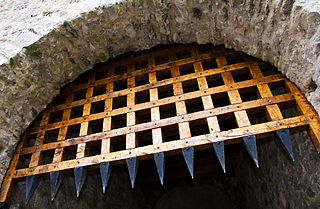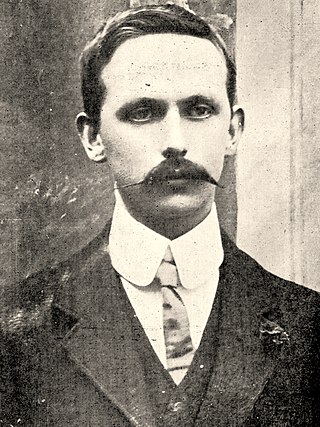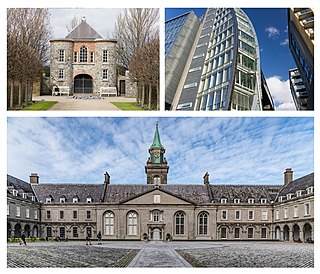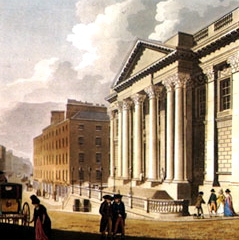
Leinster House is the seat of the Oireachtas, the parliament of Ireland. Originally, it was the ducal palace of the Dukes of Leinster. Since 1922, it is a complex of buildings, of which the former ducal palace is the core, which house Oireachtas Éireann, its members and staff. The most recognisable part of the complex, and the "public face" of Leinster House, continues to be the former ducal palace at the core of the complex.

A portcullis is a heavy vertically-closing gate typically found in medieval fortifications, consisting of a latticed grille made of wood, metal, or a combination of the two, which slides down grooves inset within each jamb of the gateway.

The Royal Hospital Kilmainham in Kilmainham, Dublin, is a former 17th-century hospital at Kilmainham in Ireland. The structure now houses the Irish Museum of Modern Art.

The Chapel Royal in Dublin Castle is a 19th-century Gothic revival chapel which served as the official Church of Ireland chapel of the Household of the Lord Lieutenant of Ireland from 1814 until the creation of the Irish Free State in December 1922, which terminated the office of Lord Lieutenant. In 1943, the chapel was reconsecrated as a Catholic place of worship and rededicated as the Church of the Most Holy Trinity, but it has not been used for worship since 1983.

Parliament House in Dublin, Ireland, was home to the Parliament of Ireland, and since 1803 has housed the Bank of Ireland. It was the world's first purpose-built bicameral parliament house. It is located at College Green.

Éamonn Ceannt, born Edward Thomas Kent, was an Irish republican, mostly known for his role in the Easter Rising of 1916.

Kilmainham is a south inner suburb of Dublin, Ireland, south of the River Liffey and west of the city centre. It is in the city's Dublin 8 postal district. The area was once known as Kilmanum.
The architecture of Ireland is one of the most visible features in the Irish countryside – with remains from all eras since the Stone Age abounding. Ireland is famous for its ruined and intact Norman and Anglo-Irish castles, small whitewashed thatched cottages and Georgian urban buildings. What are unaccountably somewhat less famous are the still complete Palladian and Rococo country houses which can be favourably compared to anything similar in northern Europe, and the country's many Gothic and neo-Gothic cathedrals and buildings.

The Liberties is an area in central Dublin, Ireland, located in the southwest of the inner city. Formed from various areas of special manorial jurisdiction, separate from the main city government, it is one of Dublin's most historic working class neighbourhoods. The area was traditionally associated with the River Poddle, market traders and local family-owned businesses, as well as the Guinness brewery, whiskey distilling, and, historically, the textiles industry and tenement housing.

Collins Barracks is a former military barracks in the Arbour Hill area of Dublin, Ireland. The buildings now house the National Museum of Ireland – Decorative Arts and History.

Francis Johnston was an Irish architect, best known for building the General Post Office (GPO) on O'Connell Street, Dublin.

The Royal Hibernian Military School was founded in Dublin, Ireland in 1769, to educate orphaned children of members of the British armed forces in Ireland.

Thomas Cooley (1740–1784) was an English-born Irish architect who came to Dublin from London after winning a competition for the design of Dublin's Royal Exchange in 1768.

St. Werburgh's Church is a Church of Ireland church building in Dublin, Ireland. The original church on this site was built in 1178, shortly after the arrival of the Anglo-Normans in the town. It was named after St. Werburgh, abbess of Ely and patron saint of Chester. The current building was constructed in 1719. It is located in Werburgh Street, close to Dublin Castle.

The Royal Victoria Eye and Ear Hospital is a public teaching hospital in Dublin, Ireland. The Royal Victoria Eye and Ear Hospital in Dublin was founded in 1895 and is the National Referral Centre for both Eye and Ear, Nose & Throat disorders.

Sir William Robinson (1645–1712) was the Surveyor General of Ireland from 1670/71 until 1700. Born in England, Robinson was appointed to the post of Surveyor General by John Berkeley in his first year of office as Lord Lieutenant of Ireland.

The Richmond General Penitentiary was a prison established in 1820 in Grangegorman, Dublin, Ireland as an alternative to transportation. It was part of an experiment into a penitentiary system which also involved Millbank Penitentiary, London. Richmond and Millbank penitentiaries were the first prisons in the United Kingdom of Great Britain and Ireland to specialise in reform rather than punishment. The building was designed by the architect Francis Johnston and decorated by George Stapleton. The building ceased to be a penitentiary in 1831, and later became part of the Richmond Asylum.

Rory O'More Bridge is a road bridge spanning the River Liffey in Dublin, Ireland and joining Watling Street to Ellis Street and the north quays.

Hawkins Street is a street in central Dublin, Ireland. It runs south from Rosie Hackett Bridge, at its junction with Burgh Quay, for 160 metres (170 yd) to a crossroads with Townsend Street, where it continues as College Street.

The Tholsel, Dublin was an important building which combined the function of civic hall, guildhall, court and gaol. It was located on Skinners Row within the old city walls of Dublin, Ireland. It existed in various forms from after the Norman invasion of Ireland until it was finally demolished around 1809. It was one of the most important and imposing buildings in medieval Dublin and was a secular focal point within the city walls situated at a major crossroads close to Dublin Castle, St Patrick's Cathedral and Christchurch Cathedral. It was the first of several tholsels which were constructed in the major cities and towns of late medieval Ireland and the Dublin tholsel also housed the first public clock in Ireland on its tower from 1466.























